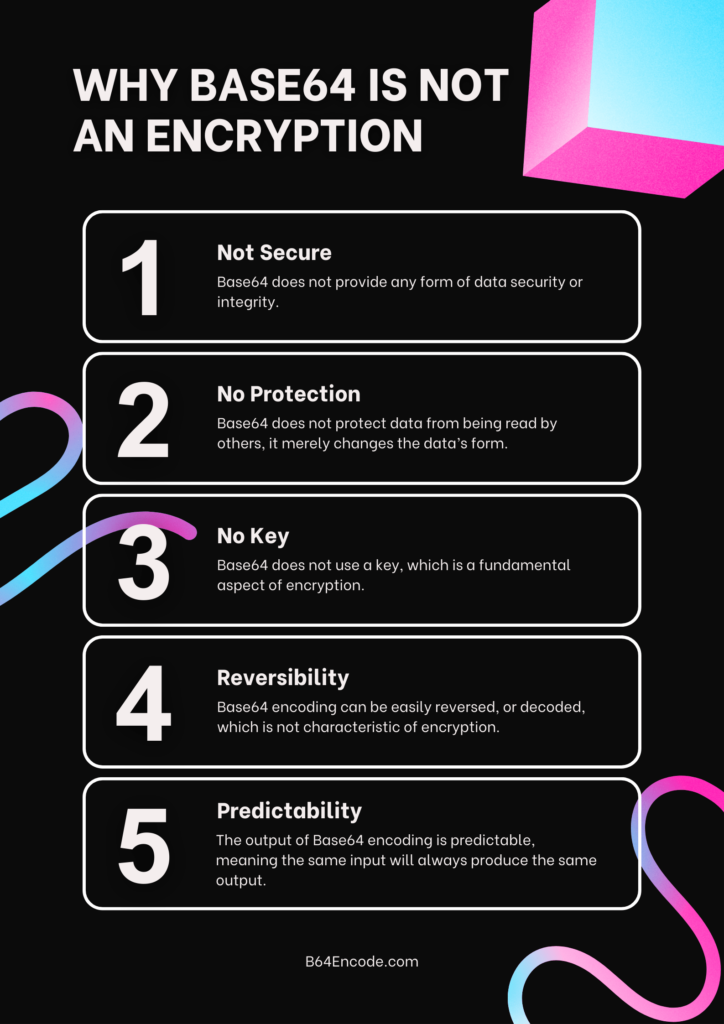This article delves into the widely embraced technique known as Base64 encoding. Interestingly, some individuals perceive Base64 as more than just a method for representation; they view it as a form of encryption. This perspective will be thoroughly explored and dissected in the following sections. As we navigate through the content, the aim is to foster a distinct understanding, drawing a line that distinguishes Base64 encoding from authentic encryption methodologies by the article’s end.
What is Base64?
Base64 is a popular binary-to-text encoding system that uses a set of 64 readable ASCII characters to represent binary data. It has characters from A to Z, a to Z, 0 to 9, as well as “+” and “/”. The use of “=” padding provides proper alignment. Its principal goal is to ease data interchange between systems that may not be capable of handling binary data adequately.
What Base64 is Not? Is Base64 an Encryption Method?
It is critical to note that Base64 is not an encryption or cryptography technology. Unlike encryption, Base64 encoding does not change the underlying content of the data to disguise its meaning. Instead, it converts binary data into a new representation to maintain interoperability with other systems and formats. This distinction is critical because conflating Base64 encoding with encryption might lead to misunderstandings about the protection it provides.

Why Do Many Consider Base64 an Encryption Method?
Several factors contribute to the widespread belief that Base64 is an encryption mechanism. One of the primary causes is the visual change in data when encoded. While encryption is a sort of transformation, Base64 encoding simply expresses binary data with a different set of characters. Furthermore, to those inexperienced with its complexities, the phrase “encoding” may indicate a level of concealment. Because of the ubiquity of this misperception, it is critical to clarify the true nature of Base64 and its particular purpose in data representation.
What is Encryption?
Encryption is the use of cryptographic algorithms to convert data into an unreadable format. Encryption’s primary goal is to protect data secrecy and security during transmission or storage. It entails scrambling the data with an encryption key, making it understandable only to those who have the appropriate decryption key.
Encryption finds application in various scenarios, including:
- Secure Communication: Encrypting data before transferring it over networks or the internet ensures that only authorized parties can comprehend it, protecting against eavesdropping and illegal access.
- Data Storage: Encrypted data saved on devices or servers is safe even if there is a physical or digital security breach.
- Authentication: Encryption is frequently used to verify the authenticity of digital signatures and certificates, ensuring transaction and communication integrity.
Examples of encryption methods include:
- AES (Advanced Encryption Standard): A well-known symmetric encryption method that is both secure and efficient.
- RSA (Rivest-Shamir-Adleman): An asymmetric encryption technique that encrypts and decrypts using a pair of keys.
Encryption plays a critical role in data protection and confidentiality, contrasting with the distinct function of Base64 encoding in data representation.
Base64 and Security Considerations
While Base64 encoding serves a crucial role in transforming binary data into a text-based format, it’s essential to understand its limitations in terms of security:
- No Encryption: Base64 encoding is not an encryption method. It does not change the intrinsic meaning of the data; rather, it facilitates data representation. In contrast to encryption, which tries to secure data by making it unreadable without proper decryption, Base64-encoded data is easily decoded by anybody with access to the encoding process.
- Data Visibility: Encoded data retains its original structure and can be reversed to its binary form. This means that sensitive data encoded in Base64 may be exposed if intercepted or read by unauthorized parties.
- Inadequate Privacy: Base64-encoded data is not secure. It should not be used to send sensitive or secret information without encryption. While not intended to be secure, Base64 is a useful way for expressing binary data in situations where encryption is not required.
- Not a Substitute for Encryption: Base64 encoding is not a replacement for encryption. They fulfill distinct functions. Encryption ensures data security and confidentiality, but Base64 simplifies data representation, which is frequently done within textual forms or URLs.
Base64 encoding should be approached with a comprehensive grasp of its intended use case. While it is useful for data representation, it should not be used for data security or privacy. Instead, encryption methods should be used when sensitive data has to be protected during transmission or storage.



